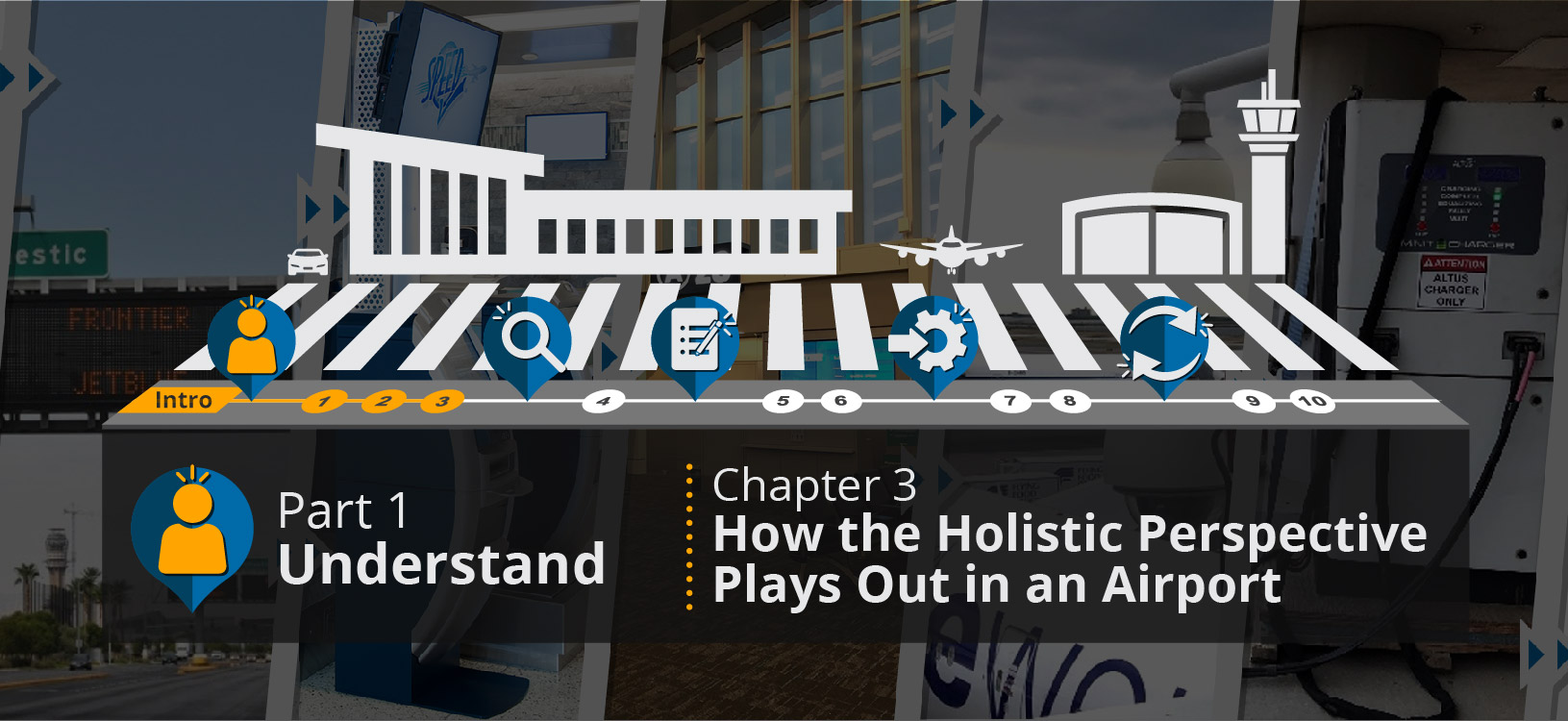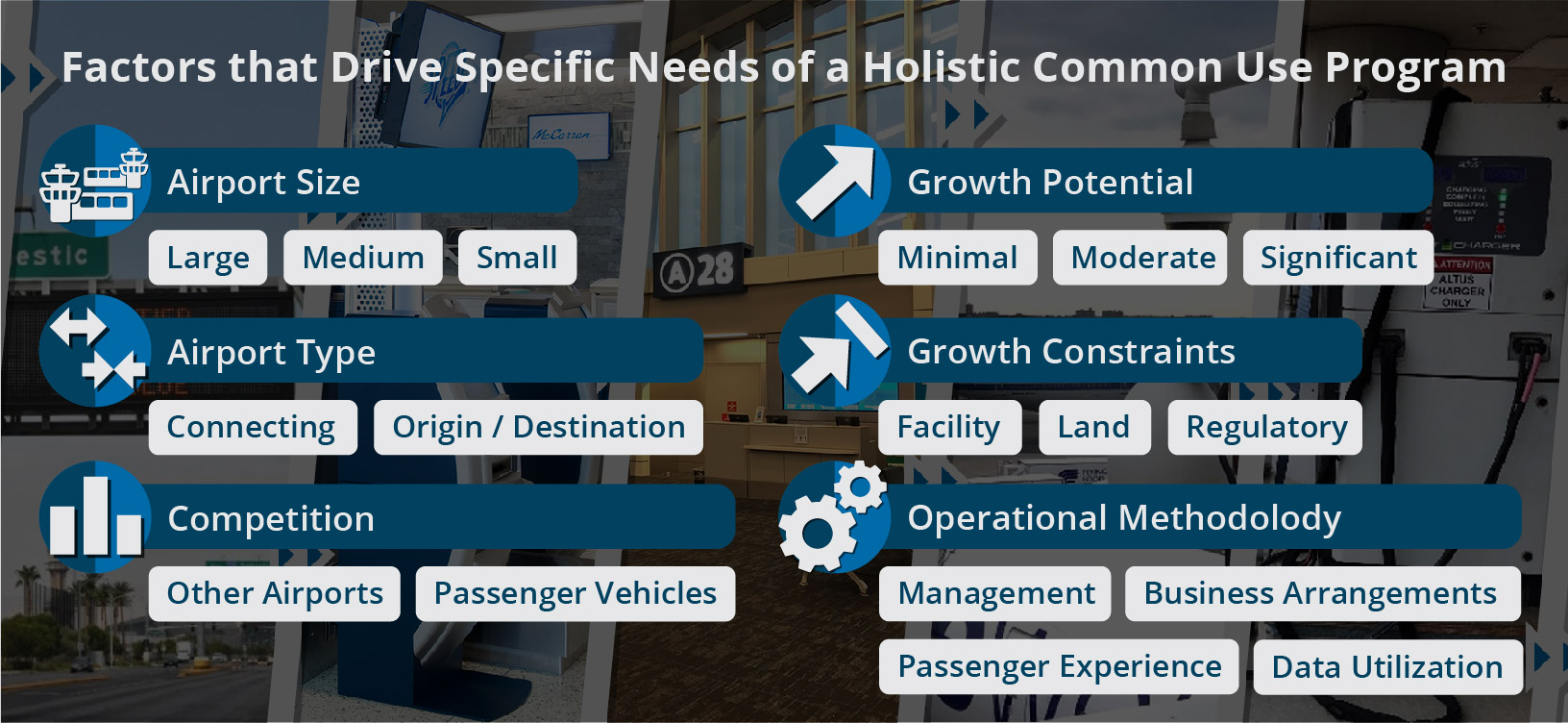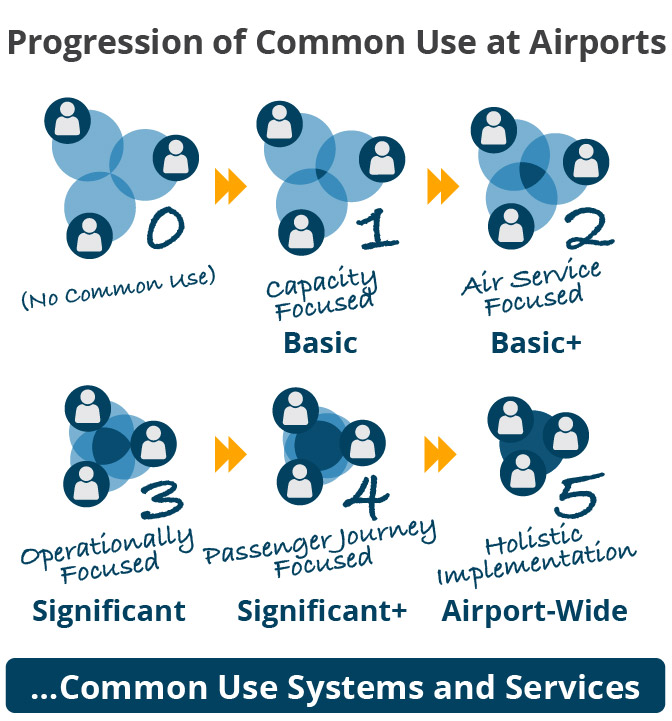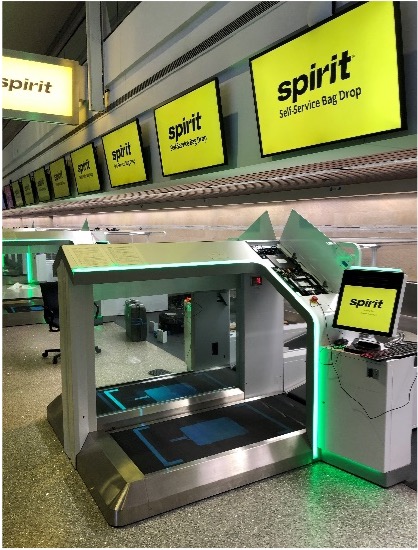
Chapter 3: How the Holistic Perspective Plays Out in an Airport
KEY FACTORS THAT DRIVE SPECIFIC NEEDS OF A HOLISTIC COMMON USE PROGRAM
Individual airports have different needs that will provide a basis for moving in the direction of a holistic common use approach. By understanding the key factors that drive the specific needs of a holistic common use program, airport operators can begin to envision the way in which their specific airport environment has begun to move toward a holistic operating model and where the opportunities to progress to the next level are likely to originate. In the context of a holistic operating model, every airport has a mix of criteria that makes them truly unique, starting from different points and perspectives and needful of their own roadmap. Figure 3.1 presents these Key Factors.

Figure 3.1: Factors that Drive Specific Needs of a Holistic Common Use Program
Each of these characteristics comes with challenges and opportunities that, when identified, can help you identify your starting point with common use. See the Deep Dive for this chapter for a full break out of these challenges and opportunities.
Progression and Need for Advancing at Different Levels
The scope and scale of the holistic common use program is influenced by the key factors described in the previous section. And since the needs of every airport will be unique, each operator should develop a personalized program within the overall framework defined in Parts 3 and 4. However, the progression of the core common use elements over time will largely look similar at most airports, with the scope and scale varying based on the extent to which each element brings value to each given airport. For illustration purposes, Figure 3.2 presents 5 levels that describe the typical progression of common use at airports.


Figure 3.2: Progression of Common Use at Airports
See the Deep Dive for this chapter for full descriptions of each progression level. It is worth noting that though this general progression does fit most airports, the underlying motivations and factors that drive the scope and scale of individual initiatives can be quite different.
Airport Stakeholders Leading and Involved
Virtually every airport employee has some level of involvement in a holistic common use program because the program itself becomes the new operating culture of the airport. The following summarizes the general role that the different stakeholder groupings have in establishing and operating a holistic common use program.
Executive
The role of the airport or airline executive in a holistic common use program is to be a champion for the proper and full use of the program.
Operations / Facilities / Maintenance / Planning
This group collectively works to address the physical and operational aspects of a common use program.
Business / Properties / Air Service Development
This group addresses the business aspects of a common use program.
Public Affairs / Customer Service / Passenger Experience
The public-facing divisions of the airport address the entirety of the common use program from the passenger experience perspective.
Technology / Innovation
The technology group is often considered the “owner” of common use because most airports think of common use as a technology system. However, in a holistic common use program, the technology and innovations groups act as a partner to all of the airport divisions in providing the needed systems and support to facilitate the common use of the facility.
Issues and Challenges by Stakeholder Group
In the early years of common use, there were several challenges with common use solutions not enabling airlines to provide the same level of quality for their passengers as they did in their proprietary environments. Over the past decade, common use solutions have matured as solution providers have sought to address many of these concerns, but some still exist. Moving forward, as more stakeholders get involved and more systems are being integrated, there are new challenges that need to be addressed.
The following provides a summary of the ongoing issues and challenges with common use at airports, gathered from interviews and case studies with over 25 entities in the aviation industry. Be aware of these as you plan for common use at your airport.
-
- Airports have issues with inconsistent experience and capability as well as support and buy-in.
-
- Airlines find challenges with inconsistency between airports and the quality of support they receive from airport operators and common use solution providers.
-
- Regulatory agencies have issues with data sharing, funding, innovation, and market access.
-
- Business partners have found issues as well, specifically the following:
-
- Common use solution providers have issues with data sharing. They also wish to be viewed as service providers and not just solution providers.
-
- Ground handlers find it challenging that equipment is often antiquated and goes missing. There are several other challenges identified in the Deep Dive.
-
- Cyber security service providers find challenges with the increased risk of security breaches due to integration with outside systems and databases.
-
- Architects/engineers note that there is a need for space and flow to be priorities when an airport is constructing new facilities.
-
- Business partners have found issues as well, specifically the following:
-
- Passengers experience trickle-down effects such as the lack of support, airport app issues, and communication difficulties.
Systems, Equipment, Emerging Technologies, Data, and Services
Traditional common use systems generally facilitate passenger processing, information, and resource allocation requirements within the airport. A holistic view of common use systems includes any airport-owned systems that support the airport stakeholders' ability to perform their operational duties. In addition to systems, the holistic perspective considers equipment, emerging technologies, and a number of services that airports may provide in support of airline operations and passenger experience. See the Deep Dive for a very in-depth description of the following areas:
-
- Passenger Processing Systems
-
- Common Use Passenger-Processing Systems (CUPPS)
-
- Common Use Self-Service (CUSS)
-
- Local Departure Control Systems (LDCS)
-
- Remote Baggage Check
-
- Self-Service Bag Drop (SBD)
-
- Automated Self-Boarding Gates (SBG)
-
- Passenger Processing Systems
-
- Airport Systems
-
- Airport Systems: Direct Common Use Support
-
- Airport Operational Database (AODB)
-
- Asset Management System
-
- Resource Management Systems (RMS)
-
- Dynamic Signage
-
- Baggage Information Displays Systems (BIDS)
-
- Flight Information Display Systems (FIDS)
-
- Gate Information Display Systems (GIDS)
-
- Premise Distribution System (PDS)
-
- Ramp Information Display Systems (RIDS)
-
- Voice over Internet Protocol Phones (VOIP)
-
- Airport Systems: Direct Common Use Support
-
- Airport Systems: Enhance Airline Experience
-
- Content Management Systems (CMS)
-
- Visual Docking Guidance Systems (VDGS)
-
- Airport Systems: Enhance Airline Experience
-
- Airport Systems: Enhance Passenger Experience
-
- Interactive Directories
-
- Visual Paging
-
- Virtual Queuing (VQ)
-
- Wayfinding/Indoor Navigation System
-
- Airport Systems: Enhance Passenger Experience
-
- Airport Systems: Support Airport Operations
-
- Airport Management Systems (AMS)
-
- Audio Paging
-
- Baggage Handling Systems (BHS)
-
- CCTV Systems
-
- Distributed Antennae Systems (DAS)
-
- Digital Twin
-
- Surface Management Systems
-
- Virtual Ramp Control Systems (VRC)
-
- Weather Data Systems
-
- Wi-Fi
-
- Airport Systems: Support Airport Operations
-
- Airport Systems
-
- Airline Systems and Equipment
-
- Baggage Tracking and Reconciliation System (BTRS)
-
- Back-Office Computer Equipment
-
- Mobile Passenger Processing Devices
-
- Operations Radio System
-
- Ground Service Equipment (GSE)
-
- GSE Charging Stations
-
- Airline Systems and Equipment
-
- Emerging Technologies
-
- Robotics
-
- Software / Analytics Tools
-
- Emerging Technologies
-
- Data
-
- Storage, Protection, and Privacy
-
- Policies and Procedures
-
- Regulation
-
- Data
-
- Services
Common Use Infrastructure Planning and Design
Implementing common use applications in a terminal requires demonstrating the benefits of common use passenger processing and terminal operations to all stakeholders. The initial capital costs for infrastructure in a common use terminal facility are typically presented as a benefit of life cycle costs, which, by itself, do not support some of the associated initial hard construction costs for infrastructure. Given all the competing program and project functional elements required for an operating terminal, it is imperative that the overriding benefit of common use terminal operations-that of providing a flexible and adaptable environment that enhances the passenger experience-is prioritized in establishing design priorities with all stakeholders. Potential long-term cost benefits for common use infrastructure need to be addressed in the early development of the terminal design, and stakeholders need to be involved in the planning, programming, and budgeting of these systems.




